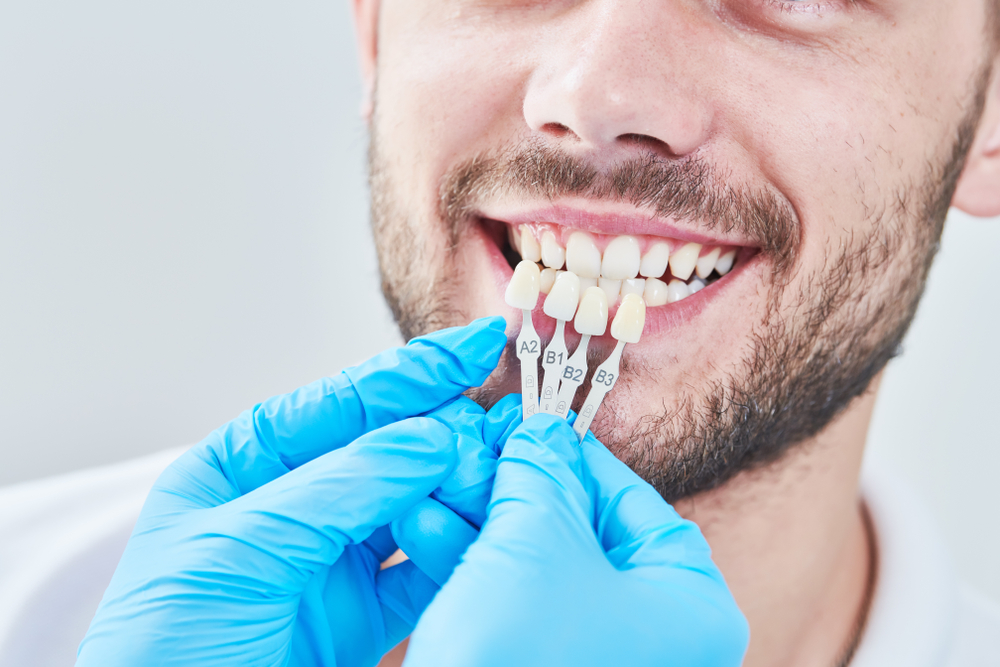
Dental Veneers treatment involves covering a damaged tooth with special materials that mimic the natural tooth structure. This procedure aims to restore lost function caused by deformities and create an aesthetically pleasing appearance that blends seamlessly with natural teeth.
In which cases can Dental Veneers Treatments be applied?
Dental veneer applications can be used to treat broken, decayed, or worn teeth due to various reasons. In cases where adequate support can be provided around the gap area caused by tooth loss, a prosthesis can be planned using neighboring teeth. In cases where support is insufficient or neighboring teeth are healthy, implant treatment may be considered for gap areas. In this case, dental veneers can be placed over the implants to treat the gap areas. Detailed information about implant applications, which have many benefits in providing tissue support, is provided in our article “Dental Implant Applications”.
Dental Veneers applications can be included in smile design plans. With Dental Veneers application in these treatments, the lengths, colors, and asymmetries of teeth can be adjusted. Natural or gaps developed due to various factors between teeth can also be corrected by creating ideal tooth contacts with these treatments.
What are the Advantages of Dental Veneers Applications?
- Dental Veneers applications allow the treatment of durability loss caused by advanced decay or tooth fractures by supporting healthy tooth tissues in the treated area.
- It enables the effective treatment of many problems causing aesthetic and functional loss in a short period.
- With careful routine oral care, they can serve in the oral cavity for a long time.
- Thanks to the recording of planning, design creation, and treatment processes in digital media, adjustments can easily be made in the treatment plan when necessary.
How is the Treatment Method chosen in Dental Veneers Applications?
In the preference of Dental Veneers applications, the dental health condition, planned aesthetic changes, patient’s habits, facial profile, and expectations from the treatment are of great importance. After determining the most suitable treatment alternatives to support teeth and general health, the treatment method to be applied is decided in consultation with the patient. Empress dental veneers, zirconium dental veneers, and porcelain laminates are among the most preferred methods due to their properties that are compatible with natural tooth tissues and support ideal aesthetics.
The material used in Empress dental veneer applications is a reinforced form of traditional ceramics used in dental treatments. With the reinforcement process, this material, which has high resistance to abrasion, stands out with its high light transmittance feature. The light transmittance feature is an important parameter for the prosthesis to create a natural appearance that is compatible with tooth tissues.
In the anterior region, this application can be frequently preferred to support aesthetics. Thanks to its high durability properties, it can also be applied in posterior teeth when suitable conditions are provided. Although it is sufficient for ideal treatment in single dental veneers in the posterior region, in planning bridge prosthesis applications, more durable applications such as zirconium dental veneers may need to be preferred.
Zirconium dental veneer is a treatment method that can be preferred in cases where high durability properties of metal elements are needed in the region. With this treatment, a prosthesis with high strength resistance to fractures can be prepared without compromising ideal aesthetic properties. It can be preferred in planned bridge or single dental veneer applications in the posterior teeth exposed to high chewing forces due to its high resistance to breakage. In addition to these applications, zirconium material can be used in the treatment of teeth in the anterior or posterior region to provide high coverage to the prosthesis in cases where discoloration is excessive.
How Does the Treatment Process Proceed in Dental Veneers Applications?
Although Dental Veneers treatments can be completed in 2 to 4 sessions on average, the treatment process may vary depending on the number of teeth to be treated, the positions and health conditions of the teeth, and the preferred method in treatment. During the initial examination, clinical and radiographic controls are performed in detail, and the treatment method and general design features are determined. Necessary records are taken within this session to create a detailed design. A fitting application is performed at the beginning of the treatment session if suitable conditions can be provided.
Fitting application allows the patient to have a more concrete idea about the result they will encounter at the end of the treatment. After determining all the design features, abrasions are made on the dental tissue to create the necessary space for the placement of the prosthesis. Measurements are taken to adapt the final state of the teeth to the design features. Temporary prostheses are placed on the teeth after abrasions to prevent sensitivity formation in the teeth during the preparation of permanent prostheses, to ensure the continuity of functional and aesthetic properties. When it is ensured that the prostheses fit ideally with the teeth, they are adapted to the tooth surface with special adhesives, and the treatment is completed.
What should be considered in the Follow-Up Process of Dental Veneers Treatment?
After following Dental Veneers applications, individuals can easily return to their daily routines without experiencing any discomfort. Minimal sensitivity may occur in the teeth where the application is made after the procedure, which is normal. The sensitivity will completely disappear on its own within a few days. It is crucial to ensure the care of the prostheses to be used in the oral cavity for a long time after the procedure. Proper brushing of teeth and routine oral care, including the use of dental floss or interdental brush, is sufficient to ensure the maintenance of prostheses.
Free Consult
Fill out the form, one of our officials will call you as soon as possible and let’s start planning your treatment by answering all your questions.
Or Call Us +90 537 957 20 37

